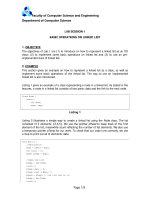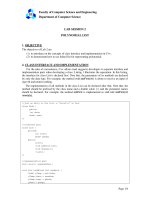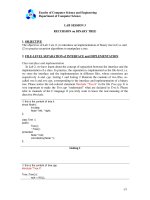Faculty of Computer Science and Engineering Department of Computer Science - LAB SESSION 3 RECURSION pot
Bạn đang xem bản rút gọn của tài liệu. Xem và tải ngay bản đầy đủ của tài liệu tại đây (202.74 KB, 3 trang )
Faculty of Computer Science and Engineering
Department of Computer Science
1/3
LAB SESSION 3
RECURSION on BINARY TREE
1. OBJECTIVE
The objectives of Lab 3 are (1) to introduce an implementation of binary tree in C++ and
(2) to practice recursion algorithms to manipulate a tree.
2. FILE-LEVEL SEPARATION of INTERFACE and IMPLEMENTATION
Class interface and implementation
In Lab 2, we have learnt about the concept of separation between the interface and the
implementation of a class. In practice, the separation is implemented as the file-level, i.e.
we store the interface and the implementation in different files, whose extensions are
respectively .h and .cpp. Listing 1 and Listing 2 illustrate the contents of two files, so-
called tree.h and tree.cpp, corresponding to the interface and implementation of a binary
tree. Please notice the red-colored statement #include “Tree.h” in the file Tree.cpp. It is
very important to make the Tree.cpp “understand” what are declared in Tree.h. Please
refer to manuals of the C language if you truly want to know the real meaning of the
directive #include.
// this is the content of tree.h
struct Node {
int data;
Node *left, *right;
};
class Tree {
public:
Tree();
~Tree();
protected:
Node *root;
void destroy(Node *);
};
Listing 1
// this is the content of tree.cpp
#include "Tree.h"
Tree::Tree() {
root = NULL;
Faculty of Computer Science and Engineering
Department of Computer Science
2/3
}
//
Tree::~Tree() {
destroy(root);
root = NULL;
}
//
Tree::~destroy(Node *root) {
if (root != NULL) {
destroy(root->left);
destroy(root->right);
delete root;
}
}
Listing 2
3. RECURSION in BINARY TREE
Recursion is an unavoidable technique to handle many operations in a binary tree. In
Listing 2, an example is given to illustrate how to use recursion to collect garbage when a
tree is deleted. Basically, to construct an algorithm for a tree binary, we should do the
following steps:
- Process the stop condition: think the simplest case (i.e. an empty tree) and
what we should do in this case.
- Process the recursion: assume that we had successfully done what we intended
to do with the left and the right sub-trees, develop a way to combine the
results to yield the desired purpose.
int
Tree::
getSize
() {
return getSizeFrom(root);
}
int Tree::getSizeFrom(Node *pNode) {
int nResult;
//stop condition: what we should do for the simplest case – an empty string
if (pNode = NULL) nResult = 0;
//recursive case: assume that we can count the size of left and right sub-trees
// what should we do to get the final result?
else nResult = getSizeFrom(pNode->left) + getSizeFrom(pNode->right) + 1;
return nResult;
}
Listing 3
Faculty of Computer Science and Engineering
Department of Computer Science
3/3
Listing 3 gives a scenario in which we try to develop a method getSize() to count the
number of nodes of the tree. To fulfill this job, we implement another auxiliary method
called getSizeFrom, which counts the number of nodes of a sub-tree whose root is a
certain node. As you can see, getSizeFrom will be implemented in a recursive manner.
4. EXERCISES
Consider the files main.cpp, Tree.h and TreeSample.cpp attached. Use this initial code to
accomplish the following tasks.
Required problems
4.1. Using the method insertAt to buil the following tree in the main program.
Print out the tree afterward.
3
5
14 7
11
19
26
6
22 190
4.2. Write methods to print the tree in LNR, LRN, NLR, NRL, RNL, and RLN
4.3. Write a recursive method to calculate the height of the tree
4.4. Write a recursive method to calculate the sum of values of all nodes in a tree.
4.5. Write a recursive method to check if a tree is a binary search tree.
Advanced problems
4.5. Write a recursive method to check if a tree is a heap
( or not.
4.6. Write methods to travel the tree in LNR and put all data in a linked list. The order of
elements in the list should be the same with that of the result of the print method in LNR.
4.7. Write a method to check the tree is a subtree
( of another tree (the second
tree is given as a parameter of the method).
insertAt(NULL,true,3,&p1);
insertAt(p1,true,5,&p2);
insertAt(p1,false,26,&p3);
insertAt(p2,true,14,&p4);
insertAt(p2,false,7,&p5);
insertAt(p3,false,6,&p6);
insertAt(p5,true,11,&p7);
insertAt(p7,true,19,&p8);









